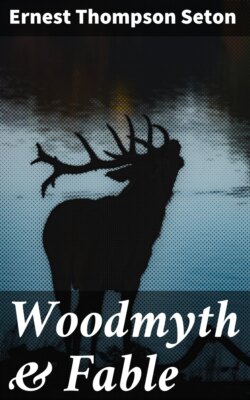Читать книгу Woodmyth & Fable - Ernest Thompson Seton - Страница 7
На сайте Литреса книга снята с продажи.
HOW THE GIRAFFE BECAME
ОглавлениеTable of Contents
AGES ago in the deserts of Africa there lived a little brown Antelope. He was not strong like the Lion, nor big like the Elephant, nor had he horns like the Koodoo, nor claws like the Leopard. He could not swim, nor could he climb or fly. When danger came he could do nothing but run away, and this he did very well.
But he was not satisfied.
One day he saw a Man, and he walked quietly up to look more closely at the strange creature of whom he had often heard. As he watched he saw a Lion crawling to spring on the Man. Now the Antelope’s mother had taught him that when he saw a Lion trying to kill some creature he must warn that creature; this is desert etiquette. So he gave a great start, and snorting out, “Lion! Lion!” he bounded past the Man, spreading the little white danger-flag that some writers call his tail. The Man heard the warning and got into a tree in time to escape the Lion. After the Lion had gone the Man called the Antelope and said:
“Little Antelope, I am a prophet of Allah; you have saved my life from that ill-informed Lion, and therefore you shall have whatever you ask.”
Then the Antelope said: “When Allah made the beasts it seems he forgot me, for he gave me no claws, teeth, horns, nor tail to flap the flies, nor strength nor power to fly, climb, or swim. Please, good Prophet, tell him that he left me out and ask him to give me the things I need.”
“But,” said the Prophet, “you cannot have all: if you have size you cannot climb a tree; if strength, you need not be swift.”
But all the Prophet’s talk was in vain; the little Antelope wanted at least horns, size, strength, a long fly-flapper tail. “Then,” said he, “I shall be content.” To this the Prophet said: “So be it, little Antelope; go to the long slope of Mount Epoch, and there roll in the Dust of Ages.”
The Antelope did so, and was overjoyed to find himself of great size and strength, with a beautiful fly-flapper tail, and two long horns on his head.
After some time, however, he found that there was yet much needed to complete his happiness. His great size called for so much more food that he had to live in the rank bushes, where he could not see the lurking dangers; and, besides, it cost him his speed, so that his troubles were increased. Therefore he again sought the Prophet and said:
“Good Prophet, it was clearly your intention to make me happy for saving your life at great risk to myself. Now, surely you are not going to make a failure of any of your good plans. Please ask Allah to complete my equipment by giving me a long neck so I can overlook the bushes where I must feed, and also increase my speed, for I need it.”
“Very good,” said the Prophet. “Now go and bathe in the Long Reach of the River called the Wear-of-Time.” The Antelope did so, and when he came out he had a long neck and legs, as he had wished.
But his long neck made grazing troublesome, and his great weight made marshy ground dangerous, so he was driven to seek his food among the bushes as tall as himself, where the ground was firm.
At length there came a very dry year when all the low foliage died, and the Antelope had eaten all he could reach and was like to die of hunger. So he sought the Prophet as before, and begged his aid to make his neck yet longer, that he might reach the topmost foliage. “As a matter of fact,” said the Antelope, “I would gladly give up these stupid horns for a few more inches of neck.”
“Very good,” said the Prophet. “Go and pass through the Burning Valley called the Tribulator of Selection.”
The Antelope did so, and found himself as he had wished, with a neck that would reach the tallest trees, but with the useless horns burnt off where the hair of his head ended.
Before long the Antelope was back with a new request. His long yellow neck was too easily seen afar; he wanted it painted like a tree-trunk; and the four hoofs he still had on each foot were a positive handicap—he knew he could get around faster if they were reduced to two on each foot. “Then,” said he, “I know I should really and truly be content.”
But in all his asking the Antelope never once asked for a change of heart, and the Prophet, out of all patience, said: “These last requests shall be granted when you have eaten of the tree called Environal Response; but to prevent you making any more you shall henceforth forever be mute.” And it was so.
There he is to-day, of vast stature, the tallest in the world, only two hoofs on each foot, no horns, voiceless—a huge creature, truly; but his heart is still the heart of the timid little Antelope, and the days of his kind are numbered.
While those of his race who were content as Allah meant them to be—nothing but swift—still dwell in safety on their wild, free deserts in the Land of the Sun.
Moral: Any fool can improve on creation.
